Jong Hak Moon
Modeling Clinical Uncertainty in Radiology Reports: from Explicit Uncertainty Markers to Implicit Reasoning Pathways
Nov 06, 2025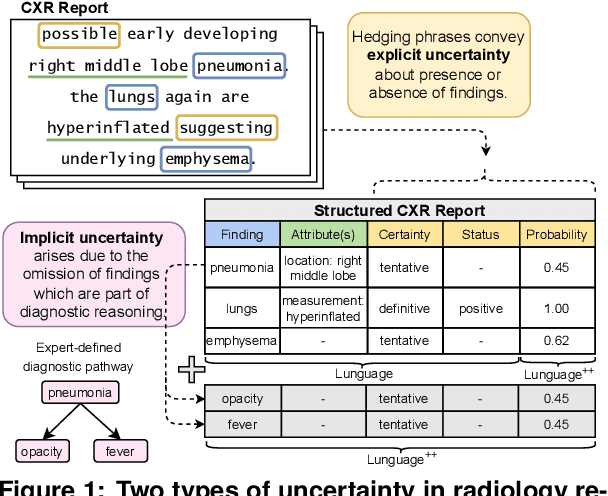
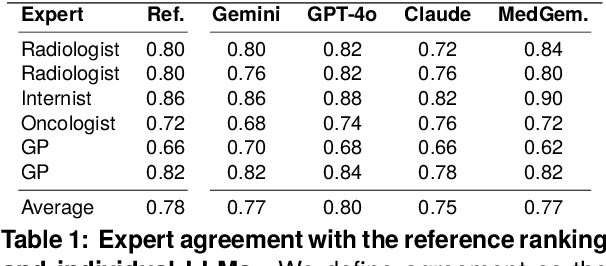
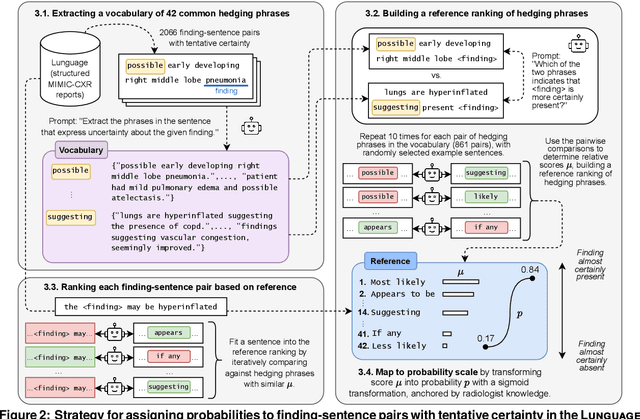
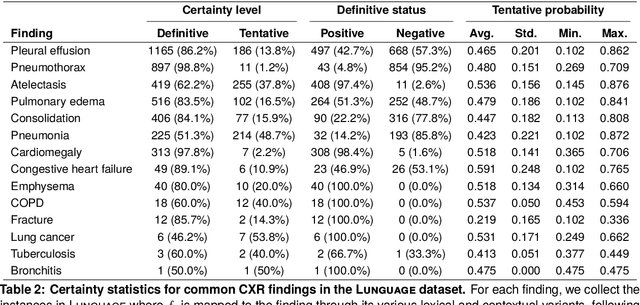
Abstract:Radiology reports are invaluable for clinical decision-making and hold great potential for automated analysis when structured into machine-readable formats. These reports often contain uncertainty, which we categorize into two distinct types: (i) Explicit uncertainty reflects doubt about the presence or absence of findings, conveyed through hedging phrases. These vary in meaning depending on the context, making rule-based systems insufficient to quantify the level of uncertainty for specific findings; (ii) Implicit uncertainty arises when radiologists omit parts of their reasoning, recording only key findings or diagnoses. Here, it is often unclear whether omitted findings are truly absent or simply unmentioned for brevity. We address these challenges with a two-part framework. We quantify explicit uncertainty by creating an expert-validated, LLM-based reference ranking of common hedging phrases, and mapping each finding to a probability value based on this reference. In addition, we model implicit uncertainty through an expansion framework that systematically adds characteristic sub-findings derived from expert-defined diagnostic pathways for 14 common diagnoses. Using these methods, we release Lunguage++, an expanded, uncertainty-aware version of the Lunguage benchmark of fine-grained structured radiology reports. This enriched resource enables uncertainty-aware image classification, faithful diagnostic reasoning, and new investigations into the clinical impact of diagnostic uncertainty.
Lunguage: A Benchmark for Structured and Sequential Chest X-ray Interpretation
May 27, 2025Abstract:Radiology reports convey detailed clinical observations and capture diagnostic reasoning that evolves over time. However, existing evaluation methods are limited to single-report settings and rely on coarse metrics that fail to capture fine-grained clinical semantics and temporal dependencies. We introduce LUNGUAGE,a benchmark dataset for structured radiology report generation that supports both single-report evaluation and longitudinal patient-level assessment across multiple studies. It contains 1,473 annotated chest X-ray reports, each reviewed by experts, and 80 of them contain longitudinal annotations to capture disease progression and inter-study intervals, also reviewed by experts. Using this benchmark, we develop a two-stage framework that transforms generated reports into fine-grained, schema-aligned structured representations, enabling longitudinal interpretation. We also propose LUNGUAGESCORE, an interpretable metric that compares structured outputs at the entity, relation, and attribute level while modeling temporal consistency across patient timelines. These contributions establish the first benchmark dataset, structuring framework, and evaluation metric for sequential radiology reporting, with empirical results demonstrating that LUNGUAGESCORE effectively supports structured report evaluation. The code is available at: https://github.com/SuperSupermoon/Lunguage
Publicly Shareable Clinical Large Language Model Built on Synthetic Clinical Notes
Sep 06, 2023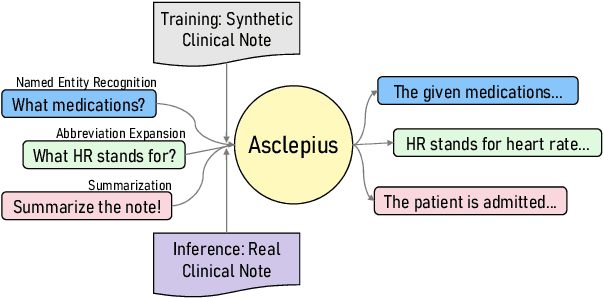

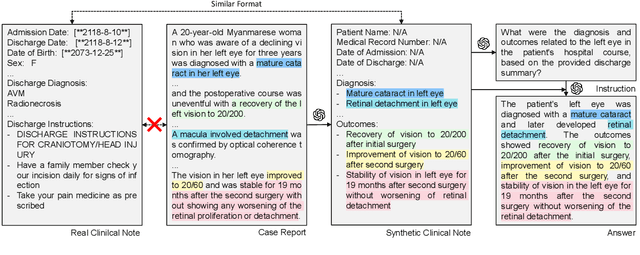
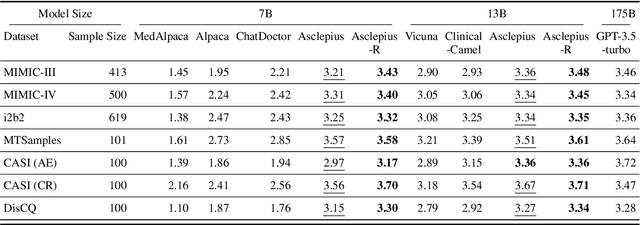
Abstract:The development of large language models tailored for handling patients' clinical notes is often hindered by the limited accessibility and usability of these notes due to strict privacy regulations. To address these challenges, we first create synthetic large-scale clinical notes using publicly available case reports extracted from biomedical literature. We then use these synthetic notes to train our specialized clinical large language model, Asclepius. While Asclepius is trained on synthetic data, we assess its potential performance in real-world applications by evaluating it using real clinical notes. We benchmark Asclepius against several other large language models, including GPT-3.5-turbo and other open-source alternatives. To further validate our approach using synthetic notes, we also compare Asclepius with its variants trained on real clinical notes. Our findings convincingly demonstrate that synthetic clinical notes can serve as viable substitutes for real ones when constructing high-performing clinical language models. This conclusion is supported by detailed evaluations conducted by both GPT-4 and medical professionals. All resources including weights, codes, and data used in the development of Asclepius are made publicly accessible for future research.
Correlation between Alignment-Uniformity and Performance of Dense Contrastive Representations
Oct 17, 2022Abstract:Recently, dense contrastive learning has shown superior performance on dense prediction tasks compared to instance-level contrastive learning. Despite its supremacy, the properties of dense contrastive representations have not yet been carefully studied. Therefore, we analyze the theoretical ideas of dense contrastive learning using a standard CNN and straightforward feature matching scheme rather than propose a new complex method. Inspired by the analysis of the properties of instance-level contrastive representations through the lens of alignment and uniformity on the hypersphere, we employ and extend the same lens for the dense contrastive representations to analyze their underexplored properties. We discover the core principle in constructing a positive pair of dense features and empirically proved its validity. Also, we introduces a new scalar metric that summarizes the correlation between alignment-and-uniformity and downstream performance. Using this metric, we study various facets of densely learned contrastive representations such as how the correlation changes over single- and multi-object datasets or linear evaluation and dense prediction tasks. The source code is publicly available at: https://github.com/SuperSupermoon/DenseCL-analysis
Multi-modal Understanding and Generation for Medical Images and Text via Vision-Language Pre-Training
May 24, 2021



Abstract:Recently a number of studies demonstrated impressive performance on diverse vision-language multi-modal tasks such as image captioning and visual question answering by extending the BERT architecture with multi-modal pre-training objectives. In this work we explore a broad set of multi-modal representation learning tasks in the medical domain, specifically using radiology images and the unstructured report. We propose Medical Vision Language Learner (MedViLL) which adopts a Transformer-based architecture combined with a novel multimodal attention masking scheme to maximize generalization performance for both vision-language understanding tasks (image-report retrieval, disease classification, medical visual question answering) and vision-language generation task (report generation). By rigorously evaluating the proposed model on four downstream tasks with two chest X-ray image datasets (MIMIC-CXR and Open-I), we empirically demonstrate the superior downstream task performance of MedViLL against various baselines including task-specific architectures.
 Add to Chrome
Add to Chrome Add to Firefox
Add to Firefox Add to Edge
Add to Edge